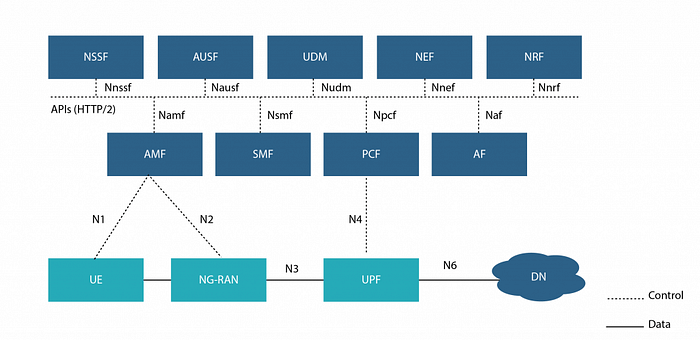The advantages of 5G service-based architecture (SBA)

An introduction to 5G service-based architecture
5G brings transformational changes to the core network with a modular and cloud-native approach. One key advancement is that it upgrades the traditional telco architecture to Service-Based Architecture (SBA), enabling more flexible service development.
Introduced to improve the modularity of the network system, SBA lets network elements or network functions (NFs) in 5G communicate with each other over a service-based interface. It allows the decoupling of NFs with more precise functionalities. Each NF provides a set of services to another NF in the SBA. These NFs communicate with each other using a more open REST-based interface rather than traditional telco protocols such as Diameter.
What does this integral change in network architecture mean for telcos?
Join the webinar: Transforming Customer Experience and Embracing Generative AI.
The SBA offers a host of benefits, including:
- Deploys as containers orchestrated by Kubernetes, allowing the core to run on non-proprietary infrastructure
- Lets new software vendors plug-and-play their NFs for a best of breeds approach
- Enables network slicing, with dynamic and efficient resource utilization
- Simplifies operations using application programming interface (APIs)
- Leverages the use of harmonized protocols such as HTTP/2 and its well-developed security mechanisms
- Facilitates seamless integration of third-party applications with the core network

How network functions communicate in SBA
Every NF in the SBA acts as a service producer and a service consumer for each NF. All NFs communicate with each other using one of two mechanisms:
- Request-response mechanism: here, a consumer NF requests a producer NF for services over HTTP/2 request, and the producer NF complies.
- Subscribe-notify mechanism: a consumer NF subscribes to certain events of the producer NF, and the producer NF notifies the consumer NF once the particular event occurs.
All of this communication is always completed using JavaScript Object Notation (JSON) objects.
The Network Repository Function — a standalone NF — acts as a unified NF repository and an internal mediator between NFs for operations such as discovery and status tracking of NF instances. For instance, if the Access and Mobility Function (AMF) wants to communicate with the Session Management Function (SMF) to establish a data session, and needs certain information about the SMF (including NF type, FQDN/IP address, endpoint information, services supported, and more) to ensure its communication with the SMF is seamless, it requests this information from the NRF. The NRF responds with the required data, facilitating smooth communication between the two.
The SBA provides an underlying REST-based stateless transaction framework for previously stateful services.
From the development standpoint, interfaces (APIs) for SBA are defined with Interface Definition Language (IDL). The interface definitions are written using YAML, and are language- and platform-independent, reducing development time and effort. They are utilized by the producer NF and consumer NF to ensure that communication between them is standardized and harmonized.
The full potential of 5G SBA
5G SBA allows any third-party application, referred by 3GPP as Application Function (AF), to interact with 5G NFs in a secured manner. Another NF — Network Exposure Function (NEF) — acts as a mediator for external communication. For example, the AF will subscribe to AMF events via NEF, the AMF will notify the NEF once the event occurs, and the NEF will then notify the AF. This is vital in enabling several next-gen use cases such as precise indoor navigation for complex buildings such as airports, train stations, hospitals, malls, trade shows, offices, industrial areas, and more.
A 5G standalone (5G-SA) network will leverage the full potential of service-based architecture, elevating the consumer’s mobile network experience while also opening a host of monetization and partnership opportunities for MNOs.
How Alepo can accelerate your 5G journey
With its vast experience in automation and digital transformation, Alepo designs advanced 5G Core and digital BSS solutions that ensure modern, flexible, secured, and operationally efficient deployments.
Alepo’s 5G Converged Core supports 4G, 5G Non-Standalone (NSA), as well as 5G SA deployments. Along with Alepo’s 5G core network functions, it provides key components of the 5G core, including subscriber data management, policy control, and charging, AUSF, UDM+HSS, UDR, PCF+PCRF, and more.
The Converged Core employs cloud- and PaaS-agnostic microservices-based software architecture and supports flexible deployment models such as public, private, and hybrid. It also supports both containerized (using Docker) as well as VNF-based deployments, facilitating matured, integrated, and robust 5G implementation at the application, infrastructural, and process levels.
Originally published on Alepo Blog.
